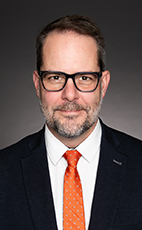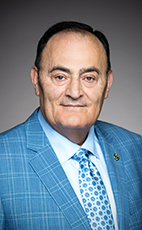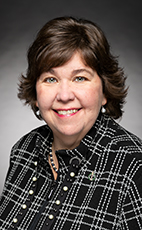44th Parl. 1st Sess.
November 28, 2023
- 12:33:09 p.m.
- Watch
- Read Aloud
Thank you very much, Mr. Chair.
My first question is for the representatives of Humanity and Inclusion Canada.
Your organization operates in nearly 60 countries. I'd like you to explain to us how it uses new technologies and innovation to improve inclusive education for persons with disabilities and children with disabilities.
54 words
- Hear!
- Rabble!
- add
- star_border
- share
- 12:33:44 p.m.
- Watch
- Read Aloud
I'll answer your question and then let Ms. McGeown comment further.
Since we're talking about innovation, I'd like to tell you about an initiative of which I am very proud. We're working on a 3D printing project in Uganda. It isn't a project that's directly related to education, but it's part of our education program. It's a different project and it's funded.
3D printing enables us to produce prostheses and orthotics for children with physical disabilities. The special feature of this project is that it's being developed and is based in the community, at existing hospitals. So we're trying to develop local capacities.
Children are constantly growing, and as you can imagine, prostheses and orthotics must constantly be remade to adapt to their growing bodies. This new 3D printing technology lets us produce orthotics and prostheses that work for individual children, enables them to play and gives them physical access to school. This is an example of an innovation that's transformative for these children.
Julia, do you want to add anything?
184 words
- Hear!
- Rabble!
- add
- star_border
- share
- 12:35:07 p.m.
- Watch
- Read Aloud
I'll just add briefly that in the education-specific sphere we are embracing the use of ed tech, or education technology, specifically to support children who might have communication difficulties with alternative and augmentative communication, sometimes known as AAC. For example, in Rwanda, we're working with children who are struggling to communicate, and we're using free apps you can get on your tablet or your phone to enable them to communicate through voice icons, which means they can communicate in the classroom.
Also, we used tablets and phones to enable children to learn sign language remotely during COVID. Actually, they've continued to use these different learning apps, as well as going to school, to help them pick up sign language and also help parents learn sign language. This was something that happened in Nepal, where we did a specific sign language app in Nepali.
We're trying to embrace it, both for teachers, to help train teachers through different websites and platforms that enable teacher training, and also for children themselves, when appropriate and where this infrastructure is available for them to access technology directly.
189 words
- Hear!
- Rabble!
- add
- star_border
- share
- 12:36:28 p.m.
- Watch
- Read Aloud
Thank you very much.
I'd like to know whether you think the Canadian government is providing adequate support for the development, purchase and distribution of new technological tools to support these children, who have very specific needs.
Is that part of Canada's strategy? Do these investments or programs take into account the use of these new technologies and tools?
61 words
- Hear!
- Rabble!
- add
- star_border
- share
- 12:37:03 p.m.
- Watch
- Read Aloud
Shall I continue? I am happy to continue.
I'll also refer you to the global education monitoring report for 2023, which is very informative about the best types of ed tech or technology and innovation that can be suitable for children with disabilities—or for all children—and how to enhance education through technology. There's a whole section there, chapters 3 and 4, on children with disabilities, so that's a really useful place to go to support this.
Typically, it's underfunded. I can't remember the figure, but it's a huge figure in terms of the gap, where the funding needs to go to do this. Particularly for children with disabilities, innovation and technology are a game-changer, so I think there's always a huge need in terms of funding.
138 words
- Hear!
- Rabble!
- add
- star_border
- share
- 12:38:07 p.m.
- Watch
- Read Aloud
Thank you very much, Ms. McGeown.
Thank you, Mr. Chair.
12 words
- Hear!
- Rabble!
- add
- star_border
- share
- 12:38:09 p.m.
- Watch
- Read Aloud
Thank you, Mr. Boulerice.
I now invite Ms. Anita Vandenbeld to take the floor for four minutes, please.
18 words
- Hear!
- Rabble!
- add
- star_border
- share
- 12:38:17 p.m.
- Watch
- Read Aloud
Thank you very much.
I'll be quick in my question. I want to follow up on something you said, Mr. Hasan. You spoke in your opening remarks about children with all types of disabilities. Here we are talking about disabilities as if they're one thing, but there's so much difference depending on what the disability is, so I wonder if you could elaborate on that.
68 words
- Hear!
- Rabble!
- add
- star_border
- share
- 12:38:43 p.m.
- Watch
- Read Aloud
I have to tell you that I'm not a disability expert, but what I know from working with people living with disabilities in a different context is that whenever there is a disability you can see, people focus on that one. Quite often, you will see an educational program talking about ramps, school infrastructure and everything, but we forget developmental disabilities and disabilities you get from being in a very stressful conflict situation. You get so many different types of it, so whenever we design a program and we talk about disability-inclusive education, it is important to take all of this into consideration.
That's why I go back to the same narrative I have been talking about, which is data. You collect data about the disabilities of children, but if you are not able to really understand the different types of disabilities and to train people to collect data in a very consistent manner, you'll never be able to capture that narrative to inform your strategy. That's why we say that it's not “one size fits all”. We need to really understand there are different types and different implications for your strategies and programming.
202 words
- Hear!
- Rabble!
- add
- star_border
- share
- 12:40:05 p.m.
- Watch
- Read Aloud
I saw a lot of nodding when you said that.
Ms. Delorme, I wonder if you have anything to add, or if anybody else wants to add to that.
29 words
- Hear!
- Rabble!
- add
- star_border
- share
- 12:40:18 p.m.
- Watch
- Read Aloud
Thank you very much.
I'm happy to share the floor. I realize that Humanity and Inclusion has been speaking a lot, but I think we've given a number of different examples. We've given a number of examples on physical disability, everything from ramps to wheelchairs, but also realizing that if you think about the pathways to school, we're not talking about a nice paved sidewalk; we're talking about rocky roads that get washed out because of climate change and flooding.
Julia has given some great examples around communication and various developmental disabilities. I think we're starting to get a picture here, so I'll pass the baton very quickly.
115 words
- Hear!
- Rabble!
- add
- star_border
- share
- 12:41:04 p.m.
- Watch
- Read Aloud
Ms. Evans also wants to respond.
6 words
- Hear!
- Rabble!
- add
- star_border
- share
- 12:41:10 p.m.
- Watch
- Read Aloud
Thank you so much.
As we talk about these various types of disabilities, I'd just draw attention to the complexity of what it means to work in classrooms with about 100 children, sometimes with different and overlapping disabilities. I just want to draw attention to the importance of really investing in teacher capacity building on an ongoing and continued basis, to make sure that teachers are getting the support they need to do this effectively.
Again, that's where we believe play can actually be really effective in helping them manage a large classroom with different disabilities. They can leverage some of the students who are capable of leading smaller groups in a play-based activity to make sure everyone is getting the individualized support and attention they need.
Thank you.
132 words
- Hear!
- Rabble!
- add
- star_border
- share
- 12:41:48 p.m.
- Watch
- Read Aloud
Thank you.
Mr. Simms, the floor is yours for 40 seconds, please.
12 words
- Hear!
- Rabble!
- add
- star_border
- share
- 12:41:55 p.m.
- Watch
- Read Aloud
Thank you. I'll be very brief.
I think the fact that there is such a range of different types of disabilities and the fact that diagnosis is very poor mean that the operative word when we're talking about disability inclusion is “inclusion” rather than “disability”. It's about making sure that the schools—in particular the teachers Tracey was talking about—are in a position to respond to the needs of children, whatever those children require when they come to school and how they get to school.
That, I think, is the paradigm shift we're looking to have when it comes to the breadth and the range, particularly in the challenging contexts that we're talking about.
I'll stop there.
130 words
- Hear!
- Rabble!
- add
- star_border
- share
- 12:42:33 p.m.
- Watch
- Read Aloud
Thank you.
Now, I'll invite Mr. Lake for four minutes, please.
12 words
- Hear!
- Rabble!
- add
- star_border
- share
- 12:42:38 p.m.
- Watch
- Read Aloud
Thank you, Mr. Chair.
I've known most of you for a long time through maternal, newborn and child health work, through the Muskoka initiative and the work done on that, which Canada really led on. It's interesting, Mohammed, talking about data. We could look at data. We knew what the numbers were, and we knew that we made a tremendous impact towards what the world had agreed was a problem, a very significant problem on maternal mortality and the mortality of kids under five.
Now we're looking at the situation here. Tim Shriver was here last week, talking about the urgency of this situation. He said, “The problem is not the disability. The problem is not intellectual and developmental disability. The problem is fear, neglect, indifference and oversight. The problem is us. The problem is urgent, and the problem is now.”
When we're having these conversations among organizations focused on disability—Humanity and Inclusion is here today, and Special Olympics and Inclusion International were here the other day—I sense that there is a real urgency. Of course, if you talk to families, you sense that real urgency in the worlds they're in.
To conclude my round of questioning here, I'm interested in what each of your takeaways is from this meeting. What can you do now, in the coming weeks or months, in terms of your organizations that will have an impact for these families and these individuals around the world who need that urgent attention now?
I'll start with CARE.
263 words
- Hear!
- Rabble!
- add
- star_border
- share
- 12:44:22 p.m.
- Watch
- Read Aloud
One thing that can be done most immediately is integrating the issue of how we deal with it as an attitude and belief, because what you say is right—the problem is with us. The problem is not with the people who are living with disability. It is our fear, our lack of belief in their ability to contribute and to be productive individuals that is stopping us.
Therefore, if we can integrate our health programming in our communities where we have a direct contact with the communities, and if we can create spaces where we are enabling the parents to come out and not hide their children with disability and then demand these services from their schools, that would be one thing we can do most immediately and integrate into in our programming as we go along.
139 words
- Hear!
- Rabble!
- add
- star_border
- share
- 12:45:20 p.m.
- Watch
- Read Aloud
3 words
- Hear!
- Rabble!
- add
- star_border
- share
- 12:45:23 p.m.
- Watch
- Read Aloud
I think for us at Right To Play, what I'm taking away from today's conversation is the added value that all these different partners are bringing to this important space. I think we've spoken to the play-based approach and particularly the way we think it can dismantle some of the barriers that children with disabilities face in the education system, whereas other partners have demonstrated, specifically with respect to technology, the way they're leveraging their assets.
I think bringing each of our specific assets to the table and collaborating is something we'll be thinking a lot about.
103 words
- Hear!
- Rabble!
- add
- star_border
- share
- menumenu
- notificationsnotifications
- home
- mailmail
- searchsearch














